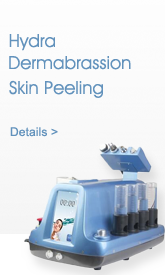USD; Free shipping* $500+
All one has to do is attend a trade show, open the back pages of one of our professional magazines or search the Internet to find a myriad of skin care devices based on the use and application of sound waves, for home or professional use, which promise untold benefits. Who of us can say we have not been tempted by the claims of extraordinary, magical results coupled with mega profits?
If a skin care device sounds too good to be true—
chances are highly likely it is. Estheticians beware!
All one has to do is attend a trade show, open the back pages of one of our professional magazines or search the Internet to find a myriad of skin care devices based on the use and application of sound waves, for home or professional use, which promise untold benefits. Who of us can say we have not been tempted by the claims of extraordinary, magical results coupled with mega profits?
But, how do we really know what works and what doesn’t with ultra- sound machines? How can we determine who to buy from and who do we believe on the claims?
Types of ultrasound
There are two major types of ultrasound (US) technology used in skin care devices: high frequency and low frequency. Rest assured there is a world of difference in the application and effectiveness of each as related to skin care.
No matter what the level of ultrasound used, it is not a panacea in our industry. There are more outlandish and unsubstantiated claims than one could imagine. For example, a quick Internet search revealed the following description of an ultrasound machine from Asia for sale in the United States: “Multifunction Ultrasonic Body and Skin Care Machine with the following features—smooths wrinkles, cleans freck- les and pouches under the eyes, cleans the skin and promotes weight loss.” One manufacturer claims its machine can perform a nonsurgical facelift with ultrasound that “yields great results.”
There are many such devices on the market, many from China and Korea, promising similar results. Prices range from several hundred dollars to more than $10,000. Can these claims be true?
How ultrasound works
Before Delving into the science behind ultrasound, I need to explain hertz, the measurement unit used to gauge the strength of sound waves named after the German physicist Heinrich Hertz.
A hertz is a measurement of cycles per second;
1 hertz is one cycle per second; 100 hertz is 100 cycles per second; 1 kilohertz (kHz) is 1,000 cycles per second; and 1,000,000 cycles per second is a megahertz (MHz).The more cycles, the faster the sound travels.The more time between cycles, the slower the waves travel. The faster the cycles (e.g., MHz) the closer the waves are to each other. This fact is critical, according to university scientists, for the application and effectiveness of ultrasound in skin care.
Ultrasound (US), sound at a frequency greater than can be heard by humans, is also referred to as sonophoresis. Low frequency is generally referred to as under 120 kilohertz (kHz) while over that is called high frequency. Most ma- chines sold to skin care professionals are in the range of between 1 megahertz and 3 megahertz (MHz) or high frequency.
Science behind ultrasound
Some of the most notable studies on the effects of ultrasound were conducted at the Massachusetts Institute of Technology (MIT), the University of California, Santa Barbara and Ben Gurion University. This research found that low-frequency US (20 to 100 kHz) yielded better penetration than higher levels. Researchers showed that low-frequency US produced the transport of molecules through the stratum corneum from the direct mechanical impact of gas bubbles collapsing on the skin surface, causing micro jets and shock waves that propel products.
Several faculty members at the University of Geneva also confirmed that low-frequency US allowed, for a time, the transport of molecules through the intercellular lipid bilayers found in the stratum corneum while the thermal or heating effects from high-frequency US were not nearly as effective. The higher the frequency, the more heat generated, the less effective the transport of products, and the less there is any mechanical reaction. Also, in improperly designed machines, heat and excessively high frequencies may cause bleeding and infection as the skin barrier can be compromised.
Alan Bunting, president of DermaWave, an authority on ultrasound, describes three basic frequencies in the higher range used in many skin care devices. He has found that 1Mhz will penetrate 40mm into tissue, which is too deep for the face. Three MHz will penetrate 3 to 5mm, which is too shallow. Two MHz frequency is considered ideal for the face because it penetrates about 11mm.
The shape of the ultrasound beam is critical to achieving beneficial effects in the form of in- creased blood circulation. Focused ultrasound beams are a characteristic of most devices available. Focused ultrasound is cheap to make but offers a very small, pinpoint treatment area so treatments are totally ineffective and take a long time to perform correctly. Collimated beams have a parallel treatment beam close to the size of the applicator or sound head. This means a much larger area of tissue is treated in a much shorter time frame.
Before you buy
Before purchasing an ultrasound device, be clear on what you want it to do. Decide on what the goals and objectives of your treat- ment are. If you are only concerned about skin cleaning, modest removal of debris or creat- ing a source of heat, one type of US may be right for you. If your objective is to increase the penetration of active ingredients, another might be more appropriate.
2013 by iBeautymachine.com














